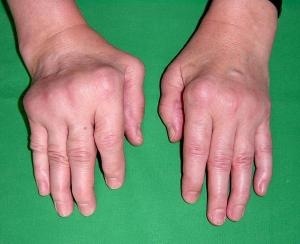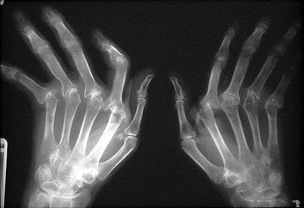Arthritis, or joint inflammation, occurs when the cartilage that normally covers the joint surfaces and allows them to glide smoothly “wears out.” Arthritis can occur in any joint in the body, but is very common in the hand and wrist and can bother you even during seemingly easy activities like writing or opening jars!. Osteoarthritis, post-traumatic arthritis, and rheumatoid arthritis are the most common arthritic conditions in the hand.
Rheumatoid arthritis affects cells that line and normally lubricate the joints (synovium). This systemic condition can affect multiple joints all over your body. Your synovium becomes inflamed and erodes, or “eats away” cartilage and bone, stretching soft tissues, causing the joints to be unstable and your fingers or hands to appear deformed. Tendons also can rupture, or tear, with minimal trauma. Rheumatoid arthritis of the hand is most common in the wrist and finger knuckles (metacarpophalangeal and proximal interphalangeal joints).
As in osteoarthritis, your symptoms can include stiffness, swelling, and pain. A sausage-shaped deformity of the finger, creaking sounds during movements, and/or drifting of the fingers away from the thumb can be observed. Trigger finger and carpal tunnel syndrome can develop from tendon inflammation, which also can cause inability to move fingers because of tendon rupture. Joint instability or deformity may occur.
Rheumatoid arthritis is diagnosed by your doctor using history, physical examination, radiographs, and laboratory tests.
Treatments are aimed at relieving pain, restoring function, and minimizing progression of the disease. Anti-inflammatory medication can be helpful. Disease-modifying drugs which help keep the immune system from creating inflammation around the joints are prescribed and monitored, usually by rheumatologists. Hand therapy can be used for exercises, splinting, paraffin wax treatments, and activity modification.
Surgery can prevent tendon rupture by significant inflammation or roughened bony areas. Tendons that already have ruptured are treated by grafting or tendon transfer. Arthritic joints can be fused (so that they don’t move and therefore don’t hurt) or replaced. Your hand surgeon can help you decide what is the best treatment for you.


Rheumatoid arthritis affects multiple joints in the hands. You can see the swelling and the deformity at this patient’s “MCP” joints where the fingers meet the hand.
For more information about resources available for those with arthritis, contact the Arthritis Foundation.
Please join us at the next Walk to Cure Arthritis at the Detroit Zoo!